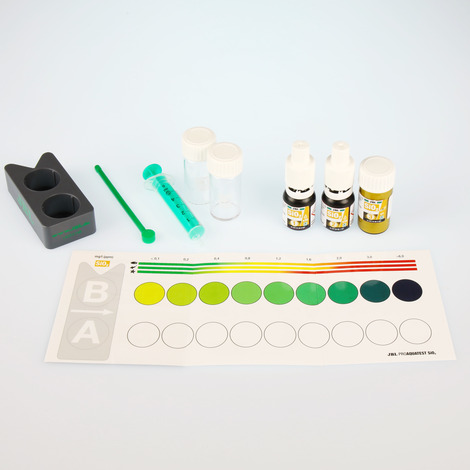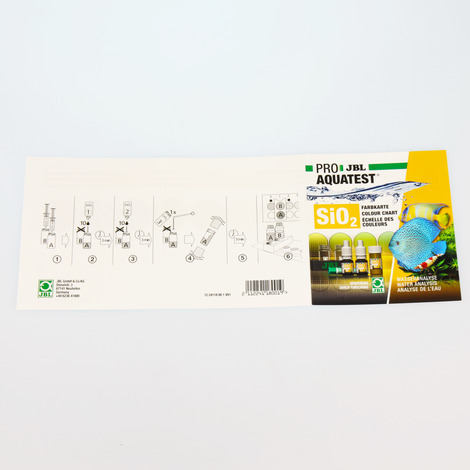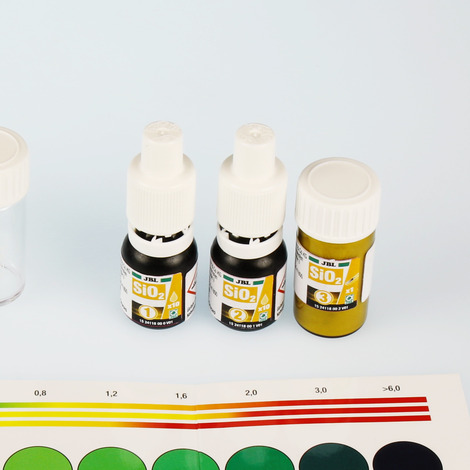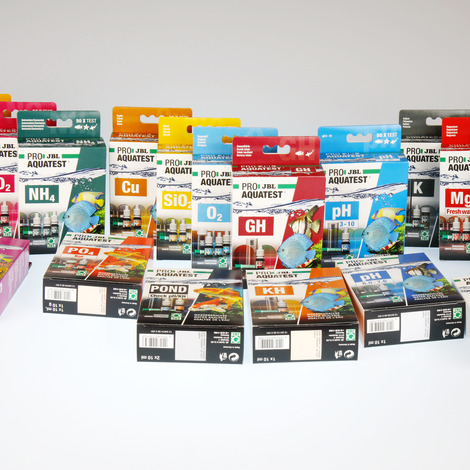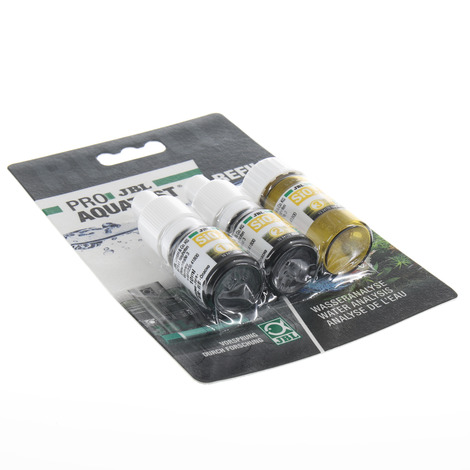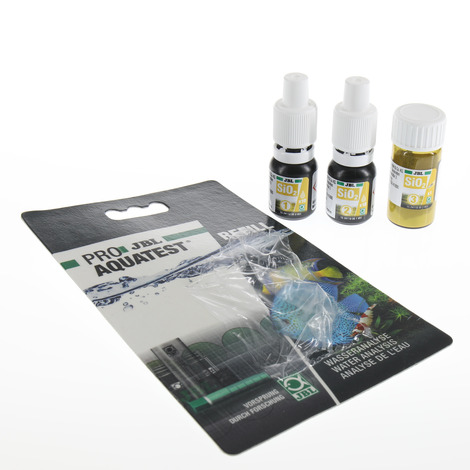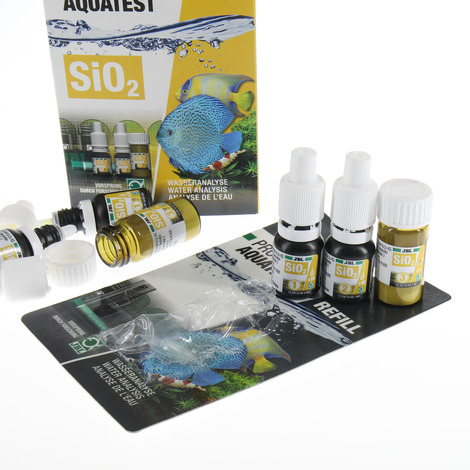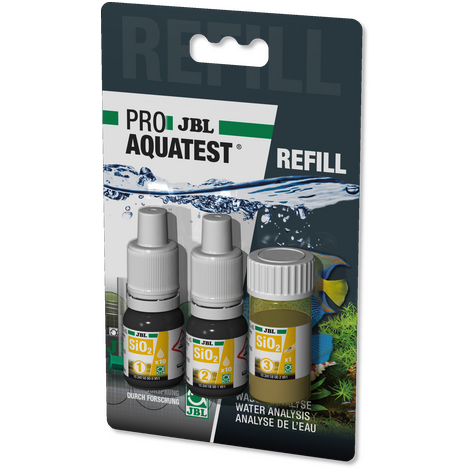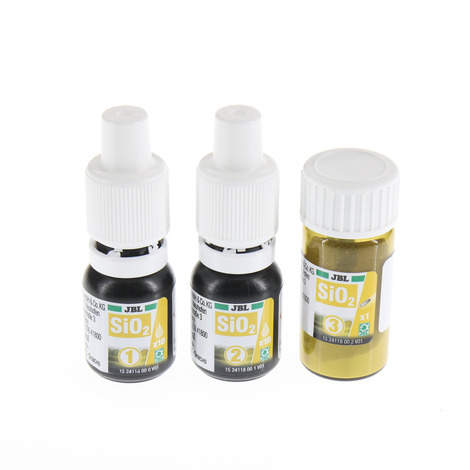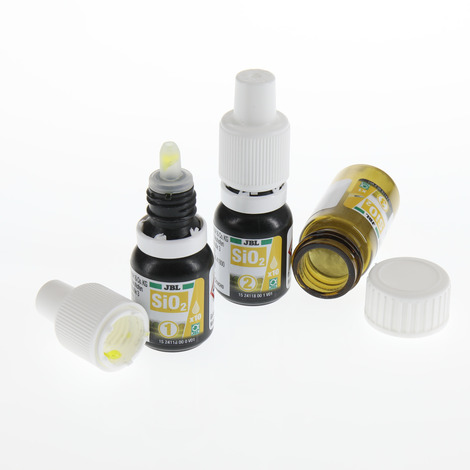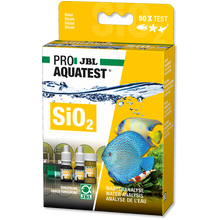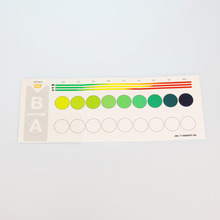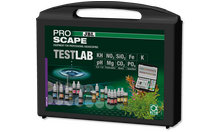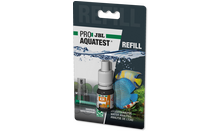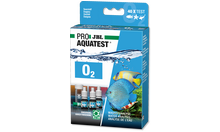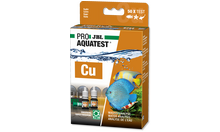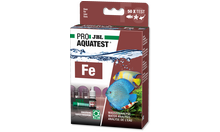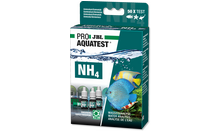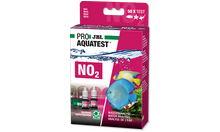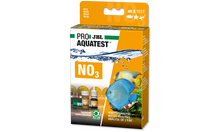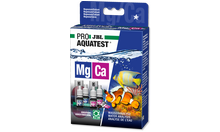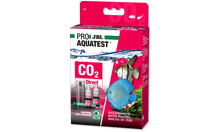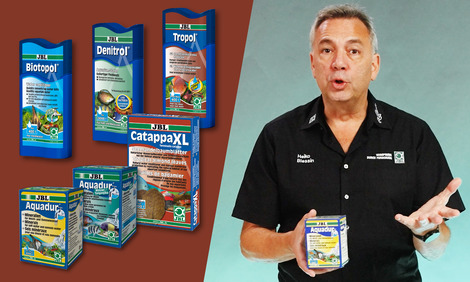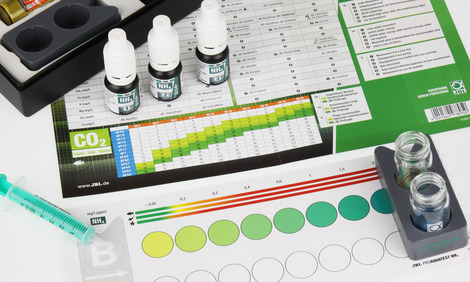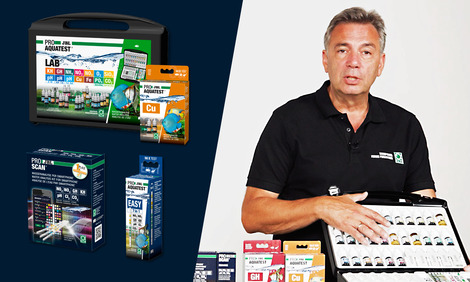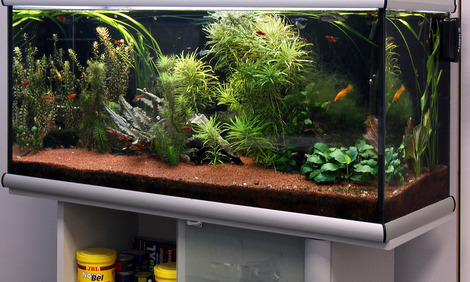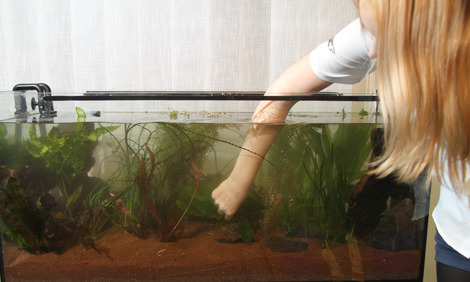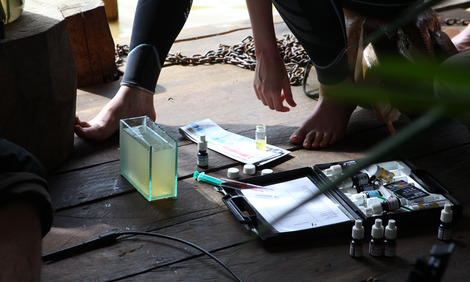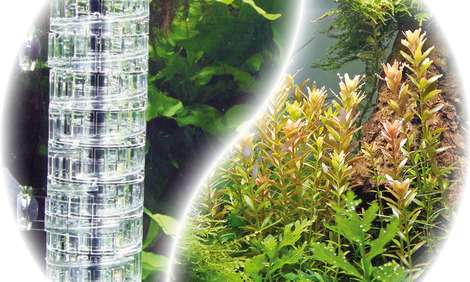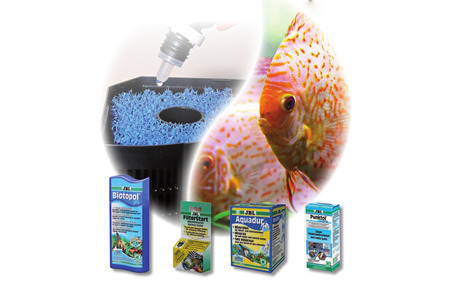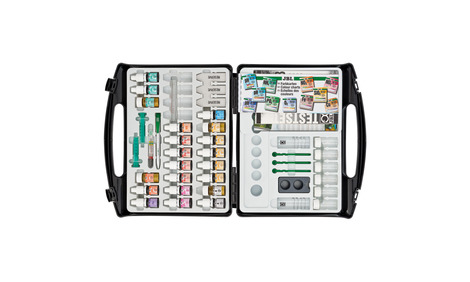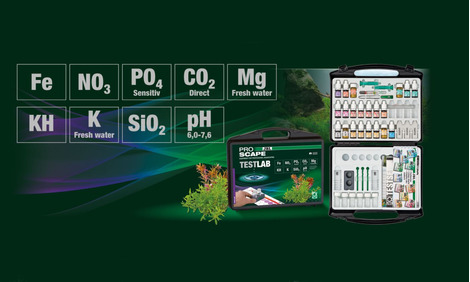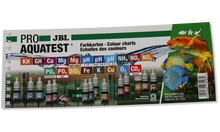Unequal consumption of individual water test reagents
The liquids of one reagent are empty, the powder is still half-filled. Can't you just buy individual bottles? No, because the JBL refill packs always contain all the reagents as a set and need to be replaced together. There is a reason for this. The reagents age when they are first opened and should therefore be disposed of completely as soon as one of the reagent bottles is empty. The unequal consumption is due to the fact that some test procedures require an individual number of drops, depending on the existing value in the aquarium water. So one needs more, the other less. The liquids can be emptied completely. In the case of powder, you cannot use the quantity you need if there is only a residual amount left. Thus the quantity is on the generous side, so that the range is ensured even with low liquid consumption.
Where can I find the record sheets for the documentation of my water analysis?
Have you lost your record sheets, used them all up, or need them in another language?
In the appendix of this FAQ you will find PDF files for printing them out in German, English and French.
Why are there different recommendations and values on the colour chart of the water test?
With the JBL PROAQUATEST drop tests you have a laboratory comparator system which compensates the inherent colouration of the water and at the same time enables non-chemists to carry out an accurate and safe water analysis. To ensure that water testing monitors the life of your fish and provides the greatest possible safety, you will find an evaluation adaptable to three different applications.
Above the different coloured measuring points are numbers, three symbols and a colour band for each.
The symbols stand for the following applications:
Fish = freshwater
Koi = garden pond
Starfish = marine water
The colour band tells you the meaning of the value determined in green (everything OK), yellow (attention) and red (need for action). In addition you will find numbers that reflect the value in mg/l for the respective colour field.
The first two (freshwater and pond) colour bands belong to the upper number row. Marine water belongs to the lower number row.
Why do the values differ?
Due to the high salt concentration in marine water, the colouring of the reaction is not as intense as in freshwater (which also includes pond). Consequently, the value for the same colouration is greater than in freshwater
Why do the recommendations differ?
Every habitat reacts differently to certain nutrient concentrations. In the garden pond, for example, constantly changing temperatures and light intensity can jeopardise the value more than in freshwater, where, unlike in the pond, these factors are constant and necessary additives are supplied. That’s why the recommendations are green for one area of application, yet yellow for the other.
Renk kartımı kaybettim. Test için renk kartını indirebilir miyim?
Renk kartlarını indirilmek üzere JBL ana sayfasına koymuyoruz, çünkü gerçeğe sadık bir renk baskısı için ilgili renk kalibrasyonuna sahip yazıcılar gerekir ki bu da her evde kolayca rastlanan bir cihaz değildir.
Renk tablosu paketini ilgili ürün sayfasında ve aşağıdaki yedek parça mağazasında yedek parça olarak bulabilirsiniz: https://www.jbl.de/en/products/detail/8732/jbl-proaquatest-assortiment-color- grafik
Su testinin ölçüm değeri ölçeğin dışında kalırsa ne yapabilirim?
Bir ölçümde renk kartının üzerindeki ölçeğin sonuna ulaşırsanız, daha sonraki testleri distile su ile (örn. JBL Dest) seyrelterek ölçeği bir kaç kat büyütebilirsiniz.
Uygulama aşağıdaki gibidir: Numuneyi distile su ile seyreltin ve ölçümü tekrarlayın.
Bunun detayı şöyledir:
JBL TS test seti: 5 ml yerine 10 ml akvaryum suyu alın. Şimdi 1 damla 0,5 °dGH'ye karşılık gelir.
JBL KS test seti: 5 ml yerine 10 ml akvaryum suyu alın. Şimdi 1 damla 0,5 °dGH'ye karşılık gelir.
Not: 10 ml numune su kullanıldığında renk oluşumu ilk damlalarda 5 ml numune su ile yapılan dolumdan daha zayıftır. Okunurluğun daha iyi olması için ölçüm kabını beyaz bir altlığın üzerine koyun.
JBL NH4/NH3 amonyum/amonyak test seti, JBL NO2 nitrit test seti, JBL Fe demir test seti ve JBL Cu bakır test seti:
2,5 ml numune + 2,5 ml dist. su: Sonuç çarpı 2
1 ml numune + 4 ml dist. su: Sonuç çarpı 5
0,5 ml numune + 4,5 ml dist. su: Sonuç çarpı 10
JBL NO3 nitrat test seti, JBL SiO2 silikat test seti, JBL PO4 fosfat sensitive test seti ve JBL Mg magnezyum test seti Tatlı su:
5 ml numune + 5 ml dist. su: Sonuç çarpı 2
2 ml numune + 8 ml dist. su: Sonuç çarpı 5
1 ml numune + 9 ml dist. su: Sonuç çarpı 10
JBL PO4 fosfat test seti Koi High Range:
2,5 ml numune + 2,5 ml dist. su: Sonuç çarpı 2
1 ml numune + 4 ml dist. su: Sonuç çarpı 5
JBL K potasyum test seti:
7,5 ml numune + 7,5 ml dist. su: Sonuç çarpı 2
3,75 ml numune + 12,25 ml dist. su: Sonuç çarpı 5
1,5 ml numune + 14,5 ml dist. su: Sonuç çarpı 10
JBL CO2 direct test seti, JBL Ca kalsiyum test seti ve JBL Mg+Ca magnezyum+kalsiyum test seti:
Gerek yoktur.
Kullanma talimatında renkleri karşılaştırmak için karşılaştırma blokunun kullanılması gerektiği belirtiliyor.
Bu işlem karşılaştırma bloku olmadan da yapılamaz mı?
Yoksa ölçüm için bu karşılaştırmadan elde edilecek bir faktöre mi ihtiyaç var?
Renk kartları karşılaştırma bloku ile birlikte kullanılacak şekilde tasarlanmıştır. Ayrıca karşılaştırma blokunun boş su numunesiyle kullanılması sayesinde suyun kendi rengi de dengelenmiş olur.
Bu yüzden karşılaştırma bloku kullanılmadığında okumada sapmalar olacağı hesaba katılmalıdır.
Su testlerim açıldıktan sonra 9 ay geçmiş olmasına rağmen hâlâ işlevselliğini koruyor mudur?
Prensipte açılmış olan ayıraçların raf ömrü orijinal ambalajında kapalı olarak korunanlardan daha kısadır. Raf ömrünün ne kadar kısaldığı ayıraçların nasıl kullanıldığına ve saklama koşullarına bağlıdır. Bu nedenle bir ayıracın 9 ay sonra doğru sonucu göstermeme olasılığı yüksektir. Ancak bunu değerlendirmek için daha fazla bilgiye ihtiyaç vardır.
JBL SilikatEx uyguladıktan sonra silikat içeriği düşmüyor.
Silikat testi hâlâ koyu mavi ilâ siyah arası bir renk gösteriyor ki bu da litrede 6 mg'ın üzerinde silikat olduğu anlamına geliyor.
Silikat testi ile elde edilen > 6 mg/l'lik bir değer suda 6 mg/l'den daha fazla silikat olduğunu gösterir. Silikat içeriğinin bu değerin ne kadar üzerinde olduğu bu testle saptanamaz. Silikat miktarı 10 veya 50 mg/l veya daha fazla olabilir. Bugün bir çok bölgede şebeke suyunda mevcut silikat miktarı 40 mg/l'nin üzerindedir. Bu konuda en doğru bilgi şebeke suyu tedarikçisinden alınabilir, ya da ölçüm yapılacak olan su, ölçüm yapılmadan önce silikat içermeyen, örn. iki kez distile edilmiş suyla seyreltilir. Seyreltme için ozmoz suyu kullanılacaksa bunun silikat içeriği de belirlenmelidir. JBL Osmose 120 silikat içeriği 40 mg/l olan çıkış suyundan 0,4 ilâ 1,2 mg/l silikat içeren bir permeat elde eder.
Silikat değerlerinin bu kadar yüksek olduğu hallerde JBL SilikatEx'in silikatı azaltıcı etkisi ancak ölçülecek suyun benzer oranda seyreltilmesiyle kontrol edilebilir.
500 g JBL SilikatEx sudan 5000 mg silikat bağlar.
400 g JBL SilikatEx Hızlı bağlanır yakl. Sudan 12000 mg silikat çıkar.
Hesap örneği:
Suyunda başlangıçta 50 mg/l silikat bulunan 100 l kapasiteli bir akvaryumda:
100 l x 50 mg/l = 5.000 mg silikat.

